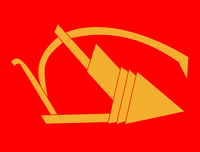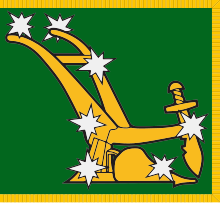Plough flag
 From Wikipedia - Reading time: 6 min
From Wikipedia - Reading time: 6 min

The Plough flag (simplified Chinese: 犁头旗; traditional Chinese: 犁頭旗; pinyin: lítóu qí) is a red banner with a white or yellow plough positioned in the center of it, widely used in the period of the Northern Expedition as the flag of the Chinese Peasants' Association.[1]
Symbolism
[edit]
The plough symbolizes the peasants' leadership in rural areas, and the red color stands for the victory of the communist revolution. When it is depicted in works of art, it is generally shown in conjunction with Mao Zedong and/or armed peasants. An example of this can be found in an illustrated pamphlet titled "'This is fine' – In memory of the 44th anniversary of the publication of 'Report on an Investigation of the Peasant Movement in Hunan"',[2][3] published by the People's Press of Guangdong, where the illustrator uses the plough flag as a symbol of the peasant movement.
History
[edit]It is believed that Peng Pai (Chinese: 彭湃) was the first to use this flag in 1923, as the Chairman of the Peasants' Association[4] of Hailufeng.[5] During the period of First United Front, when the peasant movement in China was at its peak,[6] the plough appeared in the flag and membership cards of the local peasant associations in several provinces.[7] Another version of the flag, used by the left-wing of the Kuomintang, combines the plough with the Flag of the Republic of China.
After July 15, 1927, when the Chinese Communist Party (CCP) was made illegal in Wuhan,[8] the associations controlled by the CCP stopped using the "Kuomintang" version of the flag[9][10] and instead began using a version with a completely red background.[11]
After the establishment of the People's Republic of China, plough flags have been placed in several museums around the country (e.g. the museum of Guangxi[12]) as well as being featured in paintings as the symbol of the peasant movement during the Encirclement campaigns. A Caicha Opera (Chinese: 采茶戏) titled "Ode to the Plough Flag" (Chinese: 犁旗颂) was composed in Yangxin, Hubei.[13]
Compared to Starry Plough Flag
[edit]
The Starry Plough Flag is a similar banner used by the Irish Citizen Army,[14] but with imagery of the Ursa Major constellation. However, there is no evidence that Peng Pai borrowed from the Irish design.
Gallery
[edit]-
Flag of the Chinese Peasants' Association.
-
Plough Flag used by the left wing of the Kuomintang.
See also
[edit]References
[edit]- ^ "收藏快报数字报-土地革命时期农民秋收暴动旗帜" [The banner of the peasants' autumn harvest riots during the Agrarian Revolution] (in Chinese). Archived from the original on September 26, 2017. Retrieved September 26, 2017.
- ^ "活页画册之这是好的很纪念《湖南农民运动考察报告》发表四十四周年_连海中人_新浪博客" [The loose-leaf picture album is good and commemorates the forty-fourth anniversary of the publication of the "Hunan Peasant Movement Investigation Report] (in Chinese). Archived from the original on August 9, 2018. Retrieved August 9, 2018.
- ^ "Report on an Investigation of the Peasant Movement in Hunan". Retrieved August 9, 2018.
- ^ "海丰农民运动" [SITC Farmers Movement] (in Chinese). Archived from the original on September 27, 2017. Retrieved September 27, 2017.
- ^ "彭湃与陆丰农民运动 – 陆丰宣传文化网" [Peng Pai and Lufeng's Peasant Movement] (in Chinese). Retrieved September 26, 2017.
- ^ "中央通告农字第五号——农运策略[中国共产党第五次全国代表大会(一九二七年四月二十七日--五月九日)]" [Central Announcement No. 5 Agricultural Movement Strategy [The Fifth NationalCongress of the Communist Party of China (April 27th-May 9th, 1927)]] (in Chinese). June 1927. Archived from the original on September 27, 2017. Retrieved September 27, 2017.
- ^ "城步发现罕见的犁头旗" [Rare plowshare flag found in Chengbu]. 湘潮 (in Chinese) (3): 49. 2012. Archived from the original on September 27, 2017. Retrieved September 27, 2017.
- ^ "中国共产党为汉宁妥协告民众书["八七"中央紧急会议(一九二七年八月七日)](一九二七年八月十四日)" [The Chinese Communist Party's Compromise Report to the People for Hanning ["August7th" Central Emergency Meeting]]. August 7, 1927. Archived from the original on September 27, 2017. Retrieved September 27, 2017.
- ^ "Archived copy" (PDF). Archived (PDF) from the original on September 27, 2017. Retrieved September 27, 2017.
{{cite web}}: CS1 maint: archived copy as title (link) - ^ "中央对湖南全省暴动和对平江工作的决议(一九二八年六月)" [The Central Committee's Resolution on the Riot in Hunan Province and the Work onPingjiang] (in Chinese). June 1928. Archived from the original on September 27, 2017. Retrieved September 27, 2017.
- ^ "世纪黄埔——黄埔军校校史研究专家陈宇访谈录" [Century Huangpu——An interview with Chen Yu, an experton the history of the Huangpu Military Academy] (in Chinese). September 5, 2014. Archived from the original on September 26, 2017. Retrieved September 26, 2017.
- ^ "1926-1927 年容县辛下里区甘洞农民协会犁头旗_广西壮族自治区博物馆" [Plowhead Banner, Gandong Farmers Association, Xinxiali District, Rong County, 1926-1927]. Museum of Guangxi Zhuang Autonomous Region (in Chinese). Archived from the original on September 27, 2017. Retrieved September 27, 2017.
- ^ "阳新概况" [About Yangxin] (in Chinese). Archived from the original on September 27, 2017. Retrieved September 27, 2017.
- ^ "History of Starry Plough Flag". Archived from the original on September 24, 2017. Retrieved September 27, 2017.
External links
[edit] Media related to Flags with plowshares at Wikimedia Commons
Media related to Flags with plowshares at Wikimedia Commons
 KSF
KSF
